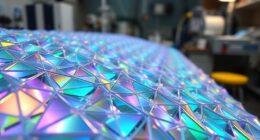Printable solar cells are flexible, lightweight panels that you can easily stick on any surface, such as walls, backpacks, or outdoor structures. They use innovative materials like perovskite or metal salts, and manufacturing methods like roll-to-roll printing, making them simple to install and scale. These cells are perfect for portable energy needs and diverse environments. If you want to explore how these sticky solar solutions work and their full potential, keep exploring the options available today.
Key Takeaways
- Printable solar cells are lightweight, flexible, and can conform to various surfaces, making them easy to stick anywhere.
- They can be integrated into objects like clothing, outdoor gear, windows, and curved surfaces for versatile use.
- Roll-to-roll manufacturing allows large-scale, cost-effective production of printable solar panels for widespread application.
- Their ease of installation and adaptability enable quick setup on rooftops, tents, umbrellas, and other portable items.
- Advances in materials and efficiency make printable solar cells a practical, sustainable energy solution for diverse environments.

Printable solar cells are an innovative technology that allows you to produce solar panels using printing techniques like inkjet, screen, or roll-to-roll printing. This approach lets you create flexible, lightweight solar devices on a variety of surfaces, making solar energy more adaptable and accessible. Instead of rigid silicon panels, you can print solar ink composed of metal salts, polymers, and fullerene directly onto plastic, metal, or paper substrates. These materials form the essential layers—cathode, anode, donor, acceptor, and buffer—that work together to convert sunlight into electricity. The use of perovskite materials, known for their high efficiency and ease of processing, has further advanced printable solar cells, especially in roll-to-roll manufacturing, which enables continuous, large-scale production similar to newspaper printing.
Printable solar cells use printing techniques to create flexible, lightweight panels with materials like perovskites for efficient, scalable energy solutions.
While traditional silicon solar panels typically achieve about 25% efficiency, printable solar cells have historically hovered around 10%. However, recent breakthroughs, particularly in flexible perovskite cells, have pushed efficiencies higher, making them more competitive. Improved performance means you get more power from a smaller area, opening new possibilities for diverse applications. The quality of printed layers and innovative cell architectures—like selecting specific emitters or designing shallower layers—continue to boost efficiency. Although there’s still room for improvement, ongoing research focuses on maintaining high performance at scale, ensuring these flexible cells can meet energy demands. Manufacturing techniques like roll-to-roll printing are crucial in scaling up production and reducing costs.
One of the key advantages of printable solar cells is how easily they can be manufactured. Printing techniques reduce material waste and simplify assembly compared to traditional silicon manufacturing. Roll-to-roll printing, in particular, enables continuous production on flexible substrates, allowing high volume, cost-effective manufacturing. Because these cells are lightweight and flexible, they can be integrated directly into construction or everyday objects, lowering installation costs and complexity. You could stick them on curved surfaces, clothing, vehicles, or even outdoor items like umbrellas, curtains, and tents. This versatility broadens the scope of solar adoption beyond static installations, making solar energy more portable and adaptable to your needs.
Frequently Asked Questions
How Long Do Printable Solar Cells Last Before Degrading?
You’re wondering how long printable solar cells last before degrading. Typically, they have a lifespan of 25 to 30 years, with performance guarantees of around 80-90%. In the early years, degradation is fast but then slows down to about 0.4-0.5% annually. After the warranty, they might still produce electricity but at reduced efficiency, so monitoring and maintenance help maximize their lifespan.
Are Printable Solar Cells Environmentally Friendly to Produce?
You might think producing solar cells harms the environment, but recent innovations tell a different story. You’ll find that printed solar cells are actually more eco-friendly to produce because they use organic, carbon-based inks instead of rare, toxic metals. Manufacturing with non-toxic solvents, scalable roll-to-roll techniques, and lower energy demands mean you’re supporting cleaner energy solutions that reduce environmental harm while helping fight climate change.
Can Printable Solar Cells Be Recycled Easily?
You wonder if printable solar cells can be recycled easily. The answer is, it depends. With innovative layer-by-layer solvent extraction methods, you can recover up to 99.97% of their materials. However, because of their layered design and unique materials, specialized processes are needed. While progress is ongoing, large-scale, cost-effective recycling systems are still under development, making recycling easier but not yet as straightforward as traditional solar panels.
What Is the Maximum Power Output of Printable Solar Cells?
Your current question asks about the maximum power output of printable solar cells. You should know that lab-scale versions can reach about 370 watts per kilogram when integrated into fabrics and up to 730 W/kg when freestanding. These cells boast an 18-fold increase in power-to-weight ratio over silicon panels. While they perform well on small scales, scaling up remains challenging, but ongoing research aims to boost their efficiency further for broader use.
Are Printable Solar Cells Suitable for Outdoor or Harsh Environments?
You wonder if printable solar cells can handle harsh outdoor conditions. Currently, they face challenges like rapid degradation from heat, humidity, and UV radiation, with some improvements thanks to advanced polymers. While recent innovations boost outdoor durability, including encapsulation and material enhancements, they still need better resistance to environmental stressors. So, these cells show promise but aren’t yet fully reliable for long-term outdoor use without additional protective measures.
Conclusion
Now, as you hold these printable solar cells in your hands, it feels like the universe conspired to bring sustainable energy to your fingertips. Imagine the places you’ll power up—your home, your gadgets, even remote adventures—just by sticking these tiny miracles anywhere. It’s almost poetic how technology and nature align, giving you the power to make a difference effortlessly. Sometimes, the smallest innovations create the biggest ripples—like a simple sticker transforming your world.










